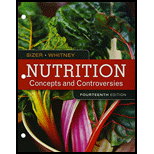
Bundle: Nutrition: Concepts and Controversies, Loose-leaf Version, 14th + MindTap Nutrition, 1 term (6 months) Printed Access Card
14th Edition
ISBN: 9781337127523
Author: Frances Sizer, Ellie Whitney
Publisher: Cengage Learning
expand_more
expand_more
format_list_bulleted
Concept explainers
Question
Chapter 3, Problem 3SC
Summary Introduction
Introduction:
In the multicellular organism, there are two types of fluids generally found such as intracellular and extracellular fluids. Intracellular fluids are found inside the body cells of the body, extracellular are the fluids, which are found in outside the body cells and hence it refers to the internal environment of the multicellular organisms.
Expert Solution & Answer
Want to see the full answer?
Check out a sample textbook solution
Chapter 3 Solutions
Bundle: Nutrition: Concepts and Controversies, Loose-leaf Version, 14th + MindTap Nutrition, 1 term (6 months) Printed Access Card
Ch. 3 - Moderate alcohol use has been credited with...Ch. 3 - Your daughter is leaving for college in the fall....Ch. 3 - Cells a. are self-contained, living units. b....Ch. 3 - Each gene is a blueprint that directs the...Ch. 3 - Prob. 3SCCh. 3 - Prob. 4SCCh. 3 - Hormones a. are rarely involved in disease...Ch. 3 - Prob. 6SCCh. 3 - Prob. 7SCCh. 3 - Prob. 8SC
Knowledge Booster
Learn more about
Need a deep-dive on the concept behind this application? Look no further. Learn more about this topic, health-nutrition and related others by exploring similar questions and additional content below.Similar questions
- The body loses water by way of the ________. a. skin b. lungs c. digestive system d. urinary system e. both c and d f. a through darrow_forwardFigure 33.21 State whether each of the following processes are regulated by a positive feedback loop or a negative feedback loop. A person feels satiated after eating a large meal. The blood has plenty of red blood cells. As a result, erythropoietin, a hormone that stimulates the production of new red blood cells, is no longer released from the kidney.arrow_forwardWhich of the following does not contribute to the process of filtration? (a) active transport by epithelial cells lining renal tubules (b) large surface area for filtration (c) low permeability of glomerular capillaries (d) high hydrostatic blood pressure in glomerular capillaries (e) podocytesarrow_forward
- SCIENCE, TECHNOLOGY, AND SOCIETY A person with kidney disease lives 10 to 15 years longer with a kidney transplant than on continued dialysis. However, in the United States many individuals have difficulty being accepted by a transplant program because they do not have adequate insurance or other resources. The immunosuppressive drugs and other medications required after the surgery are also very expensive, costing about 2500 per month. Should economic status be a deciding factor about whether a person lives or dies? or about quality of life?arrow_forwardA urinalysis reveals that the patients urine contains glucose, hemoglobin, and white blood cells (pus). Are any of these substances abnormal in urine? Explain.arrow_forwardWhich of the following statements about red blood cells is false? a. They live about 120 days before being replaced. b. They lack a nucleus and other organelles when they are mature. c. They are replaced when the hormone EPO stimulates stem cells in bone marrow. d. They are replaced as part of a negative feedback loop in which kidney cells monitor blood oxygen levels e. All the above statements are true except b, because all cells require a nucleus in order to function properly.arrow_forward
- Which of the following statements about osmoregulation is true? a. In freshwater invertebrates, salts move out of the body into the water because the animal is hypoosmotic to the water. b. A marine teleost has to fight gaining water because it is isoosmotic to the sea. c. Most land animals are osmoconformers. d. Vertebrates are usually osmoregulators. e. Terrestrial animals can regulate their osmolarity withoutexpending energy.arrow_forwardMatch the type of blood vessel with its major function. _____ arteriesa. diffusion _____ arteriolesb. control of blood distribution _____ capillariesc. transport, blood volume reservoirs _____ veinsd. blood transport and pressure regulatorsarrow_forwardBlood pressure forces water and small solutes out of blood and into nephrons during ________. a. glomerular filtration c. tubular secretion b. tubular reabsorption d. both a and carrow_forward
- Visit this site (http://openstaxcollege.org/l/normallevels) for a list of normal levels established for many of the substances found in a sample of blood. Serum, one of the specimen types included, refers to a sample of plasma after clotting factors have been removed. What types of measurements are given for levels of glucose in the blood?arrow_forwardFigure 16.10 Which of the following statements about the circulatory system is false? a. Blood in the pulmonary vein is deoxygenated. b. Blood in the inferior vena cava is deoxygenated. c. Blood in the pulmonary artery is deoxygenated. d. Blood in the aorta is oxygenated.arrow_forwardAs the text noted, two-thirds of the water and solutes that the body reclaims by reabsorption in nephrons occurs in the proximal tubule. Proximal tubule cells have large numbers of mitochondria and demand a great deal of oxygen. Explain why.arrow_forward
arrow_back_ios
SEE MORE QUESTIONS
arrow_forward_ios
Recommended textbooks for you

 Human Biology (MindTap Course List)BiologyISBN:9781305112100Author:Cecie Starr, Beverly McMillanPublisher:Cengage Learning
Human Biology (MindTap Course List)BiologyISBN:9781305112100Author:Cecie Starr, Beverly McMillanPublisher:Cengage Learning Medical Terminology for Health Professions, Spira...Health & NutritionISBN:9781305634350Author:Ann Ehrlich, Carol L. Schroeder, Laura Ehrlich, Katrina A. SchroederPublisher:Cengage Learning
Medical Terminology for Health Professions, Spira...Health & NutritionISBN:9781305634350Author:Ann Ehrlich, Carol L. Schroeder, Laura Ehrlich, Katrina A. SchroederPublisher:Cengage Learning Biology: The Unity and Diversity of Life (MindTap...BiologyISBN:9781305073951Author:Cecie Starr, Ralph Taggart, Christine Evers, Lisa StarrPublisher:Cengage Learning
Biology: The Unity and Diversity of Life (MindTap...BiologyISBN:9781305073951Author:Cecie Starr, Ralph Taggart, Christine Evers, Lisa StarrPublisher:Cengage Learning


Human Biology (MindTap Course List)
Biology
ISBN:9781305112100
Author:Cecie Starr, Beverly McMillan
Publisher:Cengage Learning


Medical Terminology for Health Professions, Spira...
Health & Nutrition
ISBN:9781305634350
Author:Ann Ehrlich, Carol L. Schroeder, Laura Ehrlich, Katrina A. Schroeder
Publisher:Cengage Learning


Biology: The Unity and Diversity of Life (MindTap...
Biology
ISBN:9781305073951
Author:Cecie Starr, Ralph Taggart, Christine Evers, Lisa Starr
Publisher:Cengage Learning